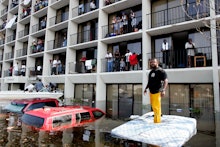Devastating Images from All Over America Show Why Climate Justice Is a Racial Issue

Ten years. That's how long the U.S. is giving itself to cut its carbon emissions by 26% to 28%, according to President Barack Obama's March compact with the United Nations.
It's a daunting task even without resistance from Republicans, who've expressed their intent to block the White House's pollution-cutting measures in Congress repeatedly, according to the Washington Post.
Yet amid all the squabbling and scientific "debate" about the realities of human-caused climate damage, one story gets overlooked: Pollution from coal plants, cars, factories, oil spills and catastrophic weather trends are all phenomena with very real — and very human — victims.
And a staggering proportion of them are low-income people of color.
The issue: Studies regularly show that communities of color and poor communities are more likely to suffer from America's environmental callousness than most whites, with disproportionately high exposure to respiratory irritants, carcinogens and other dangerous air pollutants, Scientific American reported in 2012.
One major reason is that such neighborhoods are more often located near pollution hotspots — like vehicle traffic routes, industrial plants and ports — typically due to "high housing costs and historical discrimination," the report adds.
Not to mention that many black communities across the Southern and Gulf states are facing "existential risks from sea level rise over the next century," Vann Newkirk writes at Seven Scribes.
So how does this problem look in real life? Mic's Michael McCutcheon states that 2015 is "going to be critical" for the future of climate justice, with leaders worldwide set to negotiate major sustainable development goals in September and December that will last through 2030.
But the troubling images below remind us that this battle for environmental justice is not an abstract concept to be parsed out on foreign stages, but an integral part of the movement toward racial equality as well — most notably in the United States.
1. Fresno, California
A 2012 Yale University study named Fresno one of a handful of cities with notably "unhealthful levels of fine particles and large concentrations of poor minorities," Scientific American reports. This has not been helped by California's recent drought; in 2014, the state had one of the driest years in its history.
In Fresno's case, the group hit hardest is Hispanics: At 46.9% of the city's population, they are the demographic with the highest rate of exposure to pollutants like nickel, nitrate, silicon, vanadium and aluminum — not just in the city, but nationwide as well.
Overall, Hispanics are 1.5 times as likely to be exposed to these fine particles as whites. And the results can be devastating: Aluminum exposure has been tied to low-birth weight, while the other four particles have been linked to "hospitalizations or deaths from cardiovascular and lung disease," according to Scientific American.
2. New Orleans
Ten years ago in August, the nation watched in horror as Hurricane Katrina engulfed the city of New Orleans.
Nearly 1,000 people died during the storm and its aftermath, mostly by drowning, while over 1 million more were displaced from the Gulf Coast region in general. New Orleans lost around 100,000 of its black residents for good — a devastating reduction for a demographic that makes up the majority of the city's people.
The storm proved a sobering wake-up call to the effect that hurricanes — which stand to increase significantly in number due to global warming, if the Gulf of Mexico, where the communities least equipped to recover from such storms remain predominantly poor and black.
3. River Rouge, Michigan
According to Mother Jones, the River Rouge coal plant outside of predominantly black River Rouge is responsible for "an estimated 44 deaths, 72 heart attacks and 700 asthma attacks" since it was built in the late 1950s.
Not a whole lot has changed today — the NAACP recently named the DTE Energy-owned facility the ninth worst, in terms of pollution, of the nation's 431 coal plants that were open in 2011.
However, like many such plants, the River Rouge facility is also a major job provider for people in the notably cash-strapped area. Environmentally focused local organizers like Rhonda Anderson (pictured above with her granddaughter for Mother Jones from 2012) are now working on ways to sustainably replace the work such plants provide in case they get shut down during Obama's climate cleanup.
4. South Bronx, New York
One of the poorest and most heavily Latino areas in New York City, the South Bronx illustrates a striking pattern recently outlined by CityLab: The dramatic disparity in pollution exposure between whites and people of color.
New York City — along with Philadelphia and Bridgeport, Connecticut — is one of the three worst offenders in this category in the nation. According to a 2014 University of Minnesota study cited by CityLab, non-whites on average breathe 38% higher levels of air pollution than white people — levels that, if brought down to where whites sit currently, "would prevent 7,000 deaths from heart disease in their communities each year," according to the report.
5. Los Angeles
Los Angeles is no stranger to smog, but all regions are not equal in their exposure. A Scientific American report singles out the Boyle Heights section of East Los Angeles — 90% Hispanic and surrounded by freeways and rail yards — as one of the major offenders, an area where exposure to fine particle pollution is markedly higher than whiter, richer areas of the city.
The takeaway: In the face of such overwhelming evidence, it's impossible to disconnect conversations around climate justice from those addressing racial inequality. If either goal is to be completed, it cannot ignore the other, as both stem from and perpetuate similar systems of inequality.
The next 10 years will be vital to the success of both. And to meet their goals, they must move forward in tandem.